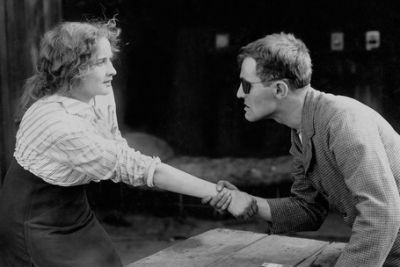
THE MYSTERY OF THE HINDU IMAGE / REGENERATION
THE MYSTERY OF THE HINDU IMAGE
(USA/1914) R.: Raoul Walsh. D.: 26'. Did. inglesi
Imprigionato alla vigilia delle sue nozze, perché accusato dell'assassinio di un uomo che conservava un talismano hindu, riesce a evadere mentre il detective ingaggiato dalla sua fidanzata smaschera i veri colpevoli. L'uomo ingiustamente accusato, che nel frattempo è stato catturato nuovamente, sarà liberato in extremis.
Restaurato dalla George Eastman House di Rochester che l'ha ritrovato nella sua collezione di 28mm, è l'unico film che a tutt'oggi risulta sopravvissuto fra le prime opere di Raoul Walsh (è il quinto titolo della sua filmografia, il terzo cortometraggio). Lo stesso Walsh, che all'epoca aveva interpretato vari ruoli di cowboy per la Pathé, impersona il detective privato che risolve il misterioso delitto e salva una vita umana.
A man is imprisoned the night before his wedding for murdering the owner of a Hindu talisman. He manages to escape while a detective hired by his fiancé unmasks the real assassins. In the meantime, the innocent groom-to-be is caught again but freed at the last minute.
Restored by the George Eastman House in Rochester, New York, from a print in its 28mm collection, The Mystery of the Hindu Image is the only known early film by Raoul Walsh (his fifth movie and third short) still around today. Walsh, who had often played the part of a cowboy for Pathé, stars as the private detective who solves the murder and saves a human life.
REGENERATION
(La rigenerazione, USA/1915) R.: Raoul Walsh. D.: 64'. Did. inglesi
Accompagnamento al piano di Antonio Coppola
Benché le prime opere di Walsh siano in gran parte andate perdute, il suo primo lungometraggio (cinque bobine) è giunto fino a noi grazie a un ritrovamento fortuito nel 1976. Il film contiene molti elementi che caratterizzeranno lo stile maturo di Walsh - compreso un protagonista che affronta la vita con piglio selvaggio - e alcune componenti destinate a essere abbandonate, come l'interessante uso della soggettiva.
A ventott'anni, reduce dall'esperienza con Griffith, Walsh aveva lasciato Los Angeles per lavorare a New York, sua città natale, dove William Fox aveva appena aperto i suoi East Coast Studios; in un'intervista con Peter Bogdanovich, Walsh disse che il progetto del film, tratto da un romanzo di successo di Owen Kildare, gli capitò tra le mani per caso dopo il rifiuto di un regista più anziano: "Oscar Apfel scelse la sceneggiatura sbagliata e a me capitò una cosa chiamata Regeneration, un film di gangster, che era proprio il mio forte dato che conoscevo tutti quei piccoli gangster e la malavita di New York... Allora andai giù al porto, gironzolai per le banchine e nei bar e lì, tra la gente appostata negli androni, trovai le fisionomie da gangster che cercavo, dei ceffi terribili".
Qui Walsh esagera un po' - da ragazzo dell'Upper West Side aveva condotto una vita da privilegiato - ma il suo rapporto con la grande città resta inconfondibilmente personale: questo non è un film claustrofobico confezionato negli esterni di uno studio cinematografico, ma la descrizione sorprendentemente ariosa di una metropoli in espansione, punteggiata da terreni incolti e da grandi aree sottosviluppate. Interpretato da Rockliffe Fellowes, scoperto da Walsh, il protagonista è un ragazzo del Lower East Side trasformatosi in un famigerato capobanda e 'redento' da un'assistente sociale (Anna Q. Nilsson) che gli insegna a leggere. Ma il suo passato violento - incarnato dall'amicizia con un criminale storpio (William Sheer) - continua a perseguitarlo fino alla tragica conclusione.
(Dave Kehr)
Although the vast majority of Walsh's early work as a director has been lost, his first feature-length film (five reels) survives, thanks to its fortuitous discovery in 1976. It contains many of the elements of Walsh's mature style - including a focus on an individual hero hurtling himself through life - as well as some components, such as an intriguing use of subjective point of view shots, that he would later abandon. The 28-year-old Walsh returned from working with Griffith in Los Angeles to his native New York at the behest of William Fox, who had just opened his East Coast studios; according to Walsh in an interview with Peter Bogdanovich, the project, based on a best-selling book by Owen Kildare, fell into his hands by chance, when a more senior director refused it: "Oscar Apfel chose the wrong script and I got a thing called Regeneration, a gangster picture, which is right up my alley because I knew all those bloody gangster kids and everybody in New York... I went down to the waterfront and around the docks and into the saloons and got all kinds of gangster types, people with terrible faces, hiding in doorways".
Walsh is exaggerating a bit here - his own youth, on the Upper West Side, was one of privilege - but his feeling for the city is unmistakably personal: this is no claustrophobic back lot confection, but a surprisingly open and airy depiction of a still growing metropolis, dotted by empty lots and large areas of underdevelopment. The protagonist, played by Walsh's discovery Rockliffe Fellowes, is a child of the Lower East Side who has grown into a notorious gang leader; his 'regeneration' occurs when a social worker (Anna Q. Nilsson) teaches him to read, yet his brutal past remains a part of him through his friendship with a murderous hunchback (William Sheer) - with ultimately tragic results.
(Dave Kehr)


Tariffe:
Aria condizionata
Accesso disabili
Tel. 051 522285











